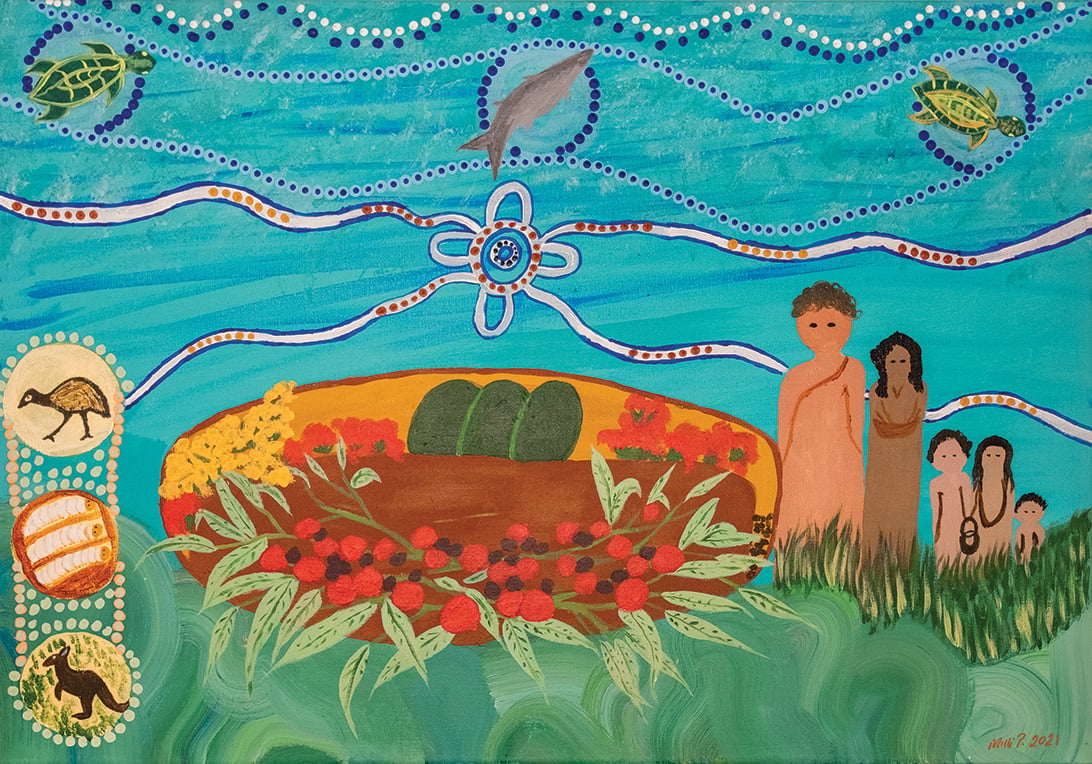Researchers are collaborating with Community Elders to find out how bush tucker and traditional food can improve the health of Aboriginal children.
Connecting closely with culture and community, the project combines traditional Aboriginal knowledge, wisdom, and ways of doing things with western science to investigate the food eaten by ancestors and by Aboriginal people today and discover how these, combined with safe sun exposure, can prevent vitamin D deficiency.
Aboriginal people have lived in Australia for tens of thousands of years and retain a deep understanding of and connection to Country. Part of living on Country is knowing which foods are good to eat, and which seasons those foods should be eaten in.
In the Bush Tucker, Safe Sun Exposure and Vitamin D Project, The Kids Research Institute Australia and Curtin University researchers are working with respected local Elders and communities on Noongar Boodja and in Bardi Jawi Country in the Kimberley to determine how locally available bush foods – together with safe sun exposure – could support vitamin D health in Aboriginal children.
Low vitamin D levels can cause poor bone health and may contribute to respiratory infections, non-infectious skin disease, chronic kidney disease, type 2 diabetes, poor mental health, and low birthweight for babies.
The project aims to identify traditional and current knowledge and attitudes about diet and sun exposure, collect samples of bush tucker to measure their vitamin D content, and work with community on ways to help increase vitamin D intake.
In work already undertaken on Noongar Boodja, the project has seen researchers, local Aboriginal Elders, community members and organisations team up to first determine what kinds of foods ancestors ate in the past and the foods Aboriginal people still eat today, then collect samples of bush tucker in season.
The plant and animal samples are then cleaned, prepared and frozen, before being sent to the National Measurement Institute in Naarm, Melbourne for analysis.
Noongar Elders Aunty Dale Tilbrook and Uncle Noel Nannup, chief investigators leading the Perth arm of the project, helped the team to understand the seasonal availability of bush tucker on Noongar Boodja and develop a list of plants and animals that form an important part of the diets of Noongar people.
The importance of being on this project is highlighted by the staggering statistics that in regional and remote Aboriginal communities, the vitamin D deficiency is around 40 per cent – which has come about due to our change of diet and lifestyle.
“The importance of being on this project is highlighted by the staggering statistics that in regional and remote Aboriginal communities, the vitamin D deficiency is around 40 per cent – which has come about due to our change of diet and lifestyle,” Aunty Dale said.
“Revisiting traditional foods and how they were gathered and used is an important component of this project, hopefully leading to a return to Country for food and wellbeing.”
Analysis of the samples will determine how much vitamin D is in each of the foods, providing communities with valuable information that can be used to encourage higher consumption of beneficial, readily available bush tucker.
The team will hold yarning circles and undertake a co-design process with community members to understand and interpret the knowledge in culturally safe ways, and develop resources that promote diets high in vitamin D, provide information about the vitamin D content of traditional foods, and provide safe sun exposure messaging specific to Aboriginal people.

Painted by respected Noongar Elder and artist Aunty Millie Penny, the project’s logo depicts a coolamon, a women’s tool for gathering food. The coolamon was used to carry the berries, leaves, and seeds collected by women and was used to grind seeds to make flour for damper. The logo also depicts other bush tucker eaten in traditional diets including turtle, emu eggs, and bardi. The logo represents a traditional, healthy diet for Aboriginal people and is tied to the project aim of encouraging Aboriginal people to include more traditional food sources in their diets.
It is hoped similar work can be undertaken in the Kimberley, where the research team has begun working with communities on the Dampier Peninsular keen to be involved.
The Kids Kimberley team member Liam Bedford said having the Elders involved was a vital part of the project.
“A lot of respect and trust is given to Elders and their knowledge of Country,” Liam said. “To have them involved and teach about vitamin D will not only build on the knowledge they already know, but it will also strengthen our health messaging in a way where the children can learn from their Elders.
Although Aboriginal people are deficient in Vitamin D, teaching them about it will help them understand a healthy diet when it comes to consuming vitamin D and sun exposure. Teaching children the importance about it plays a vital part to a healthier future.
Uncle Noel agrees culture and local knowledge are vital to the project – allowing for true collaboration between western science and knowledge passed down for thousands of years to Elders and the Aboriginal community.
“A project like this is so valuable to help inform our community of the importance of vitamin D, while keeping our cultural knowledge and ways still connected to our story of keeping healthy through systems that have been practiced for many thousands of years,” Uncle Noel said.
